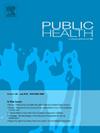巴西宫颈癌筛查及社会和健康指标的时空分析
IF 3.2
3区 医学
Q1 PUBLIC, ENVIRONMENTAL & OCCUPATIONAL HEALTH
引用次数: 0
摘要
目的了解2013 - 2022年巴西宫颈癌筛查的时空格局及其与社会健康指标的关系。这项生态学研究使用了巴西统一卫生系统信息部的癌症信息系统(SISCAN)的数据。该研究分析了巴西5570个城市中25至64岁接受CC筛查的女性。采用全局Moran’s I和局部空间自相关指数(LISA)进行聚类分析。采用纯空间扫描统计技术进行空间聚类检测。使用连接点回归评估时间趋势。采用GeoDa、SaTScan、GWR、QGIS软件进行分析。结果CC筛查比例的全局聚类分析显示出显著的空间自相关性(Moran’s I = 0.530)。筛查率较低的城市聚集在北部(阿玛马州本文章由计算机程序翻译,如有差异,请以英文原文为准。
Spatial–temporal analysis of cervical cancer screening and social and health indicators in Brazil
Objective
To identify the spatial-temporal patterns of cervical cancer (CC) screening in Brazil from 2013 to 2022 and its relationship with social and health indicators.
Study design
This ecological study uses data from the Cancer Information System (SISCAN) of the Brazilian Unified Health System's Department of Informatics.
Methods
The study analyzed women aged 25 to 64 who underwent CC screening in 5570 municipalities across Brazil. Global Moran's I and the Local Index of Spatial Autocorrelation (LISA) were employed to investigate clustering. The purely spatial scan statistic technique was used for spatial cluster detection. Temporal trends were assessed using joinpoint regression. GeoDa, SaTScan, GWR, and QGIS software were used for the analysis.
Results
The global clustering analysis of CC screening proportions revealed significant spatial autocorrelation (Moran's I = 0.530). Clusters of municipalities with low screening rates were significantly observed in the Northern (Amapá, Amazonas, Rondônia, Roraima) and Northeastern (Piauí, Pernambuco) regions. The Gini Index (β = −2.60), the Municipal Human Development Index (MHDI) (β = −10.5), and the Social Vulnerability Index (SVI) (β = −9.14) showed negative associations. Conversely, Family Health Strategy (FHS) coverage (β = 2.18) demonstrated a positive impact on screening rates. In terms of temporal trends, the screening proportion gradually increased from 5.4 % in 2014 to 10.5 % in 2022.
Conclusion
Areas with a high risk of low CC screening rates were identified in the Northern and Northeastern regions of Brazil, which are characterized by socioeconomic and demographic disparities, vulnerabilities, and inequalities.
求助全文
通过发布文献求助,成功后即可免费获取论文全文。
去求助
来源期刊

Public Health
医学-公共卫生、环境卫生与职业卫生
CiteScore
7.60
自引率
0.00%
发文量
280
审稿时长
37 days
期刊介绍:
Public Health is an international, multidisciplinary peer-reviewed journal. It publishes original papers, reviews and short reports on all aspects of the science, philosophy, and practice of public health.
 求助内容:
求助内容: 应助结果提醒方式:
应助结果提醒方式:


